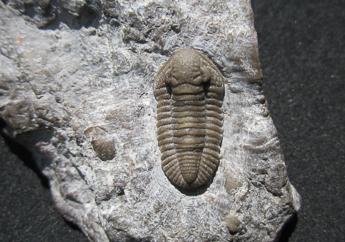Missouri Geological Survey Director: Carey Bridges, RG
Trilobites comprise an extinct class of marine arthropods that lived throughout the world’s oceans during the Paleozoic Era between 540 and 250 million years ago. They are one of the signature creatures of that era.

The name “trilobite” alludes to the three-lobed construction of their bodies, with a central (axial) lobe flanked by two side (pleural) lobes. Their bodies consisted of a head (cephalon) with two compound eyes similar to present-day insects, a body (thorax) and a tail (pygidium).
Trilobites had chitinous exoskeletons, similar to modern-day arthropods such as crabs and lobsters. Their heads and tails were stiff, whereas their thoraxes were segmented, allowing them to arch their backs and bend forward completely. Trilobites had two rows of jointed legs underneath their bodies and two antennae protruding frontward from the undersides of their heads, although antennae rarely are preserved in fossils. Body size typically measured one to two inches, but ranged from nearly microscopic to about two feet long.
Most trilobites simply crawled around on the seafloor; some may have been swimmers. Others, especially the very small ones, may have been planktonic and drifted along with the ocean currents.
When disturbed or threatened, a trilobite could protect its thinskinned and vulnerable underside by bending its body so the bottom of its head closed snuggly against the bottom of its tail, similar to the way a pill bug rolls itself into a ball.
The feeding habits of trilobites are thought to have ranged from eating organic detritus to scavenging dead organisms to predation. As the old saying goes, “big ones likely ate little ones.” In order to grow, trilobites had to shed their exoskeletons periodically.
Trilobites belong to the Kingdom: Animalia, Phylum: Arthropoda (“Arthropoda” means “joint-footed” and includes Crustaceans, Insects, Centipedes, Millipedes, Spiders, Scorpions, Trilobites, etc.), and Class: Trilobita (“Trilobite” means “three-lobed”). More than 20,000 different species representing about 5,000 genera of trilobites are known to have existed.
Trilobites and other fossils are on display in our Ed Clark Museum of Missouri Geology.
Nothing in this document may be used to implement any enforcement action or levy any penalty unless promulgated by rule under chapter 536 or authorized by statute.
For more information
Geological Survey Program
Missouri Geological Survey
P.O. Box 250
Rolla, MO 65402-0250
United States
